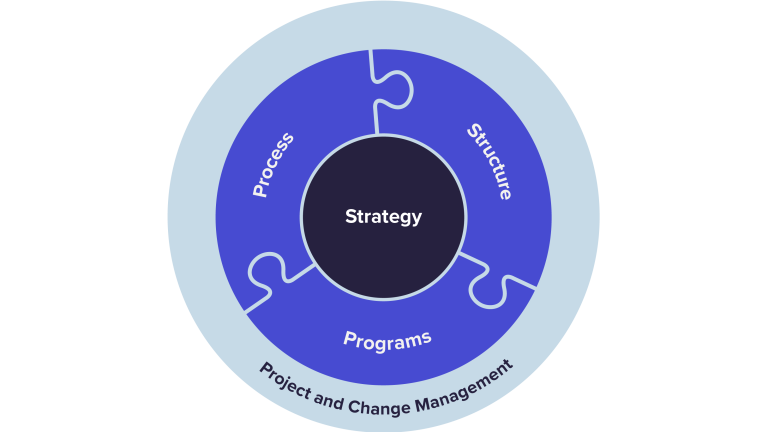Our Human-Centered Approach Inspires Workforce Transformation.

Overview
Our model drives efficiency and productivity by first addressing the critical people components of an operation through the alignment of operational processes, organizational structure, and workforce programs in support of strategically valuable work. Our human-centric approach, rooted in organizational psychology, creates sustainable organizational change by being holistic, co-creative and inclusive, and adaptive to the unique needs of each organization and team.

Strategy
Strategy plays a critical role in aligning and motivating the workforce, and it is for this reason that it sits at the center of our model. For strategic objectives to drive organizational and operational change, a critical mass of stakeholders must support the objectives, understanding both the purpose of the objectives and how their work contributes to the achievement of the objectives.
Our model motivates stakeholder buy-in by helping organizational leaders clearly define and effectively communicate strategic objectives to stakeholders and inviting those stakeholders to participate in this process of identifying the work changes that are necessary to contribute to and ultimately realize the strategic objectives.
Process
Work processes often evolve over time in response to changes in priorities, constraints, tools, and employees. Activities that no longer serve their original purpose can be preserved or enforced through habit, policy, or software and contribute to the waste of organizational resources. Additionally, undocumented and inconsistent processes across employees and teams can lead to duplicative work, inconsistent quality, costly employee onboarding and training, and the unexpected loss of critical process knowledge with the departure of a key employee.
We identify key stakeholders and invite them to participate in documenting and optimizing work processes to efficiently support strategic objectives. Through our co-creative approach, we create buy-in for process changes, capture critical organizational knowledge, and leverage the insights of those most familiar with the work. The resulting optimized processes contribute to efficiency and productivity and inform changes to organizational structure, the development of supportive workforce programming, and opportunities for high-impact investments in technology.
Structure
Work processes and organizational structure are highly interrelated. To realize the full benefit of process improvements, roles, duties, competencies, and reporting relationships should be reevaluated and realigned to ensure the employees in each new role possess the competencies necessary to support the future-state work best.
We build upon a comprehensive understanding of work activities and relationships developed during the documentation of work processes by identifying required effort and competencies at the activity level. With an understanding of work activities in the context of larger organizational processes, the volume and effort of those activities, and the competencies required to perform them effectively, we identify recommended changes to roles and structures that support strategic objectives.
Programs
Workforce programs are an essential tool through which organizations ensure they have the right people in the right place at the right time. A comprehensive understanding of the organization’s work processes reveals high-impact opportunities to leverage workforce programs in support of strategic objectives. Workforce programs can help organizations attract and retain high-performers, develop the competencies of the existing workforce, fill difficult-to-fill positions, and motivate efficiency and productivity.
We analyze historical workforce and program data and incorporate qualitative and quantitative analysis of the current workforce to identify new workforce programs and programmatic changes with the greatest impact on the success of strategic objectives. These program interventions could be as small as the design of custom training to close an identified competency gap, or as large as the development and deployment of an organization-wide performance management system.